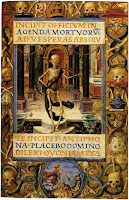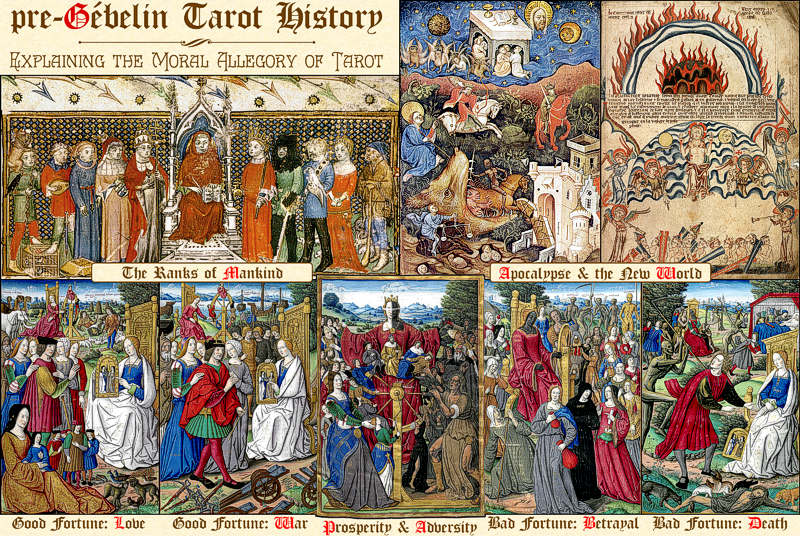Here is a small gallery of images(1) showing the Ranks of Man motif. It is another “exemplary mode” post(2), and it should be obvious that this is only a small sampling of the many hundreds of such images that could be adduced. It should also be obvious that this is the artistic and, by extension, social context in which Tarot’s lowest trumps must be understood. This collection of images is a kind of postscript to The Estates and Ranks of Man post from 2007, and other posts elsewhere(3). The point is to illustrate a pervasive sensibility that has existed since ancient times and has been illustrated in countless works of art.
This is the GENRE of the lowest trumps.

❡ Christendom in Adoration. The Ranks of Man routinely included an emperor and pope, and was used to represent Mankind in adoration of the Trinity, the Host, the Monogram of Christ, the Virgin Mary, and so on. In such an obviously honorific context, the multitude represents the Church Militant (Ecclesia Militans), living Christians who battle against “the World, the Flesh, and the Devil”. A few examples were magnificent, like Dürer’s Adoration of the Trinity. One can see an emperor, pope, and a peasant with his attribute, a long-handled flail. Note that emperor and peasant avert their unworthy eyes, while the latter is literally “hat in hand”, symbolizing humility.

 |
Details of the images are mostly left as an exercise for the reader, although here I’ve drawn attention to three key figures in the multitude. For a clean image, see this JPEG version on Wikimedia Commons. (There are several other, much inferior versions.)

 The Host and Trinity |
 The Christ Child |
 Adoration of the Trinity |
 Host, Man of Sorrows |

 The Host |
 Crucifixion & Trinity |
 Monogram of Christ |
 Holy Mother Church |

 |
The frontispiece to Margaret of Austria’s choir book (Liber Missarum, fol. 1v, Netherlands, c.1515) depicts a Ranks of Man paying tribute to Emperor Maximilian. The Emperor sits between Margaret and the young Charles V. The assembled figures – pope and clergy, nobility, townsfolk, and peasants – point to the heavens, acknowledging that the Emperor is a representative of God on Earth.


❡ Folly, Fortune, and Everyman. The Wheel of Fortune is entirely concerned with differing stations, and sometimes included princes of both Church and State. (It is worth noting that the most common configuration, rising on the left and falling on the right, echoes the composition of Last Judgment scenes, with souls rising to Heaven on the left and descending to Hell on the right.) Countless examples could be included. The Wheel was often turned by Fortune, and sometimes Folly or Death were also involved, or the lowest figure was shown as dead. These pointedly transient ranks of Mankind illustrated the Folly of Ambition, a common contemptu mundi theme. In the time of Erasmus and Brandt, even the Fool might teach an ironic lesson to Mankind.

 |

 Durer’s Wheel for Brandt’ Ship of Fools |
 Wheel of Fortune fresco with Folly & Death |
 Fortuna catching the Fool’s Wheel in her sail |

 |
This Roman mosaic from Pompeii, (c.30BC-14AD), contains cognate symbolism for each of the three sections of the trump cycle. The builder’s level, spaning the royal attributes on the left and the beggar’s attributes on the right, indicates that all ranks of man from pauper to prince are equal in some respects. The wheel indicating Fortune and the skull indicating Death represent those circumstances of equality. The butterfly, representing Psyche, symbolizes an afterlife.

 |

 Wheel of Fortune & Folly |
 Tree of the Three Estates |
 Wheel of Fortune |
 The Ranks of Man |

 |
 |
 |
 |

 |
 |
 |

 |
 |
 |

❡ Mors Omnia Aequat. In countless Memento Mori designs there were explicit references to the Ranks of Man motif, commonly including attributes of various social positions and occupations. Even the imperial and papal crowns were sometimes included. This post is already getting tiresome, so we’ll only do a few examples.

 |
 |
 |
 |

 |
 |
 |

 |
 |
 |

 |
 |
 |

And so on. In highly varied forms, a ranks of man motif appears in many memento mori and vanitas type works. The above two categories, Fortune and Death, include more sub-categories than I've taken time to include; but there are two more categories of Death allegories which are even bigger: the Dance of Death and Triumph of Death genres.

❡ The Danse Macabre. The most dramatic and universal genre involving the Ranks of Man motif is the Dance of Death. This is the most well-known use of the Ranks of Man, and also the most well-known of the various macabre genres. As such, the term Dance of Death is sometimes used broadly to include other categories, including the Three Living and Three Dead, Vado Mori, Triumph of Death, Memento Mori, and so on. A number of writers in the 19th century, starting with Paul Lacroix, correctly identified the Tarot trumps as being in this larger category. (The term Triumph of Death is probably better as a general label for the macabre genres.)
This family of designs is entirely constructed around the Ranks of Man, and in the most characteristic forms it has the Pope and Emperor as the highest-ranking subjects. It began in the early 15th century as a development from the Vado Mori cycle, and developed greatly during the next two centuries. Because these are so well known, especially the tradition based on the Paris cycle and Hans Holbein, we’ll just look at a few of my favorite examples. There are a great many catalogued and exhibited on the exceptional

 |
 |
 |

 |
 |
 |
 |

 Dance of Death |
 Dance of Death |

❡ Trionfo della Morte. The Triumph of Death genre, from monumental frescoes to Petrarchian manuscripts, often showed ranks from Pope and Emperor down to beggars and cripples, fools and children. Sometimes shown living, sometimes already dead, an assortment of figures would be included. The prevalence of these works began with the Black Death in the middle of the 14th century, and their designs are immensely varied. There is often considerable overlap between the figures in a Dance of Death grouping and a Triumph of Death grouping, so as noted above the terms are neither mutually exclusive nor jointly exhaustive. The great Triumphs of Death at Camposanto in Pisa, Bentivoglio Chapel in Bologna, the Pale Rider from Palermo, the archer and gunman at Clusone are wildly different, as is the famous Bruegel painting. From the Petrarchian tradition alone I’ve already uploaded a couple dozen examples, and this post is already huge, so ’nuff said.
Shit... okay, I have to include at least a couple examples.

 |

 From Savonarola |
 Anon. Drawing |
 Death with Devil |
 Death in Pizan |

Again, the most common feature in these works is the presence of a pope and emperor, or at least their distinctive crowns. Taken together, in an allegory, they announce Mankind as the protagonist.

 |

❡ Plague, Rosaries, and Misericordia. There are different works for all three subjects, but there are also overlapping designs. All tend to include an explicit ranks of man motif. The Plague, or Black Death, informed all of the macabre works after 1350 to one extent or another, directly or indirectly. Numerous works included a representative of God (sometimes God the Father, sometimes Christ) hurling arrows of Death at Mankind, and another representative of the Divine (usually Mary, sometimes Christ or both) as Man’s protector. According to the Church, those who faithfully recite the rosary will have the Virgin’s “special protection”, “shall never be conquered by misfortune”, will die a good death and go straight to Heaven. It’s a sweet deal. The sixteen images in this category shown below are only a few of what can be found online.

 |
 |
 |
 |

 |
 |
 |
 |

 |
 |
 |
 |

 |
 |
 |
 |

 |

❡ Extremum Judiciam. The final category here is the Last Judgment, and related End Times subjects. An explicit form of Ranks of Man motif was used in many depictions the Four Last things: Death, Judgment, Heaven, and Hell. Here are a few examples. Death in this context is yet another version of the broader death genres, an Apocalyptic Death as in the Four Horseman.

 |
 |
 |
 |

 |
 |
 |
 |

 |
 |
 |
 |

 |

Tarot may be a mystery to most Tarot enthusiasts, but when the basic structures are as pervasive as the Ranks of Man motif culminating in the Emperor and Pope, there should be at least a vague recognition of the actual historical meaning.
______________________

Notes:
✎ 1. Because the themes of this post were pervasive over a long period of European history, the examples in this post come from many areas, and from long before as well as long after the time when Tarot was invented. Very few elements of Tarot (one being the Traitor) are unique to northern Italy and a narrow period of time. Most of Tarot’s symbolism and meaning is representative of Stoic-Christian themes that were very widespread and long-lived.
✎ 2. Like the Popess exemplary mode post, which has about six dozen examples, these are not intended to be taken as sources, influences, nor even exact parallels to the related cards in Tarot. In a sense, the point is just the opposite: to show that the iconography is common and that similar iconography can be used to represent a variety of related subjects. The correct meaning of the figures in any particular work must be identified in such a way as to be consistent with that work. Tuve put it well: “the principal drift governs the meanings attributable to the incidents born upon the stream; the latter cannot take their own moral direction as they choose. If we ignore the stream’s main direction of flow, and embark on incidents which travel counter to or unrelated to it, arriving at special separable meanings for such incidents, we shall presently drown farcically, amid the laughter of the characters, who sit on the bank well protected by the natures the author gave them, only waiting for the chance to push us in.”
✎ 3. Not surprisingly, that 2007 post had some of the same images, albeit in tiny form, like the image to the right. It was only my second month of posting to the blog, and I knew even less about how to use it than I do now.




No comments:
Post a Comment